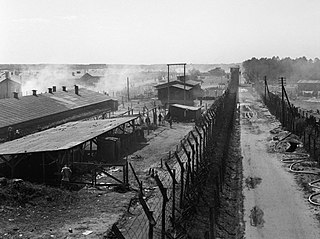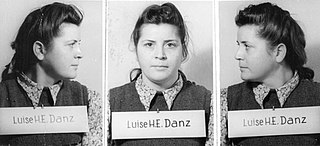
Hilde Lobauer (born 8 November 1918) was a German political prisoner and later a concentration camp guard in Auschwitz-Birkenau and Bergen-Belsen. She was known most as "the SS woman without uniform." [1] [2]

Hilde Lobauer (born 8 November 1918) was a German political prisoner and later a concentration camp guard in Auschwitz-Birkenau and Bergen-Belsen. She was known most as "the SS woman without uniform." [1] [2]
Hilde Lobauer, or Lohbauer, was born in Plauen, Germany, in 1918 and was an unmarried German mother of two. In 1940 she worked in a weaving mill but was sent to Ravensbrück as a political prisoner after refusing to move to a munitions factory in Württemberg to make munitions for the German Army. She was then sent to Auschwitz in March 1942 where she was a prisoner and Kapo in the main camp for four weeks before she was transferred to Birkenau in April 1942. [3]
During her time in Auschwitz she controlled prisoners' work, marched them through the camp, and was in charge of basic order and cleanliness. In 1944 she was selected/ordered to become an Arbeitsdienstführerin or labor leader in Birkenau where she worked the compounds "A" and "E" in the women's camp. Her role in Birkenau was similar to her role in the main camp. She took orders from Lagerführer Hasse and Arbeitsdienstführerin Mendel and gave orders to 30 or so Kapos below her. She became known as the SS woman without a uniform.

In March 1945 she was evacuated to Bergen-Belsen alongside Ilse Lothe. In Bergen-Belsen she held her position as a labor leader until the camp was liberated. Bergen-Belsen was liberated in early April 1945 by British forces, and she was taken to Celle prison to await trial. The British initially arrested her on the charge of aiding Nazi scientist Dr. Fritz Kline in his experiments. [2]
The first Belsen trials started 17 September 1945, in Lüneburg. Lobauer was a principal defendant (number 11) [4] and was represented by British Major L. S. W. Cranfield, R.A. who also represented the infamous Irma Grese, Ilse Lothe, and Josef Klippel. She was identified by many during the trial and accused of drowning women in a pool at Oswiecim, selecting prisoners for the gas chambers, and beating prisoners with a rubber truncheon. When examined by Major Cranfield she denied drowning the women or subjecting them to any excessive beatings. [5] She stated that she was forced by SS leadership to beat the prisoners and that she never beat them hard enough to break the skin. When she was examined on the stand she took accountability only for occasional beatings.
Lobauer was charged on two counts. The first count was for mistreatment of prisoners in Auschwitz-Birkenau and the second charge was for mistreatment of prisoners in Auschwitz. On 17 November 1945 at the age of 27 she was sentenced to 10 years in prison. This was then reduced to 7 years imprisonment, and she was later released 15 July 1950.

Auschwitz concentration camp was a complex of over 40 concentration and extermination camps operated by Nazi Germany in occupied Poland during World War II and the Holocaust. It consisted of Auschwitz I, the main camp (Stammlager) in Oświęcim; Auschwitz II-Birkenau, a concentration and extermination camp with gas chambers; Auschwitz III-Monowitz, a labour camp for the chemical conglomerate IG Farben; and dozens of subcamps. The camps became a major site of the Nazis' Final Solution to the Jewish question.

Bergen-Belsen, or Belsen, was a Nazi concentration camp in what is today Lower Saxony in northern Germany, southwest of the town of Bergen near Celle. Originally established as a prisoner of war camp, in 1943, parts of it became a concentration camp. Initially this was an "exchange camp", where Jewish hostages were held with the intention of exchanging them for German prisoners of war held overseas. The camp was later expanded to hold Jews from other concentration camps.

Irma Ilse Ida Grese was a Nazi concentration camp guard at Ravensbrück and Auschwitz, and served as warden of the women's section of Bergen-Belsen. She was a volunteer member of the SS.

Aufseherin was the position title for a female guard in Nazi concentration camps. Of the 50,000 guards who served in the concentration camps, training records indicate that approximately 3,500 were women. In 1942, the first female guards arrived at Auschwitz and Majdanek from Ravensbrück. The year after, the Nazis began conscripting women because of a shortage of male guards. In the context of these camps, the German position title of Aufseherin translates to (female) "overseer" or "attendant". Later female guards were dispersed to Bolzano (1944–1945), Kaiserwald-Riga (1943–44), Mauthausen, Stutthof (1942–1945), Vaivara (1943–1944), Vught (1943–1944), and at Nazi concentration camps, subcamps, work camps, detention camps and other posts.

Maria Mandl was an Austrian SS-Helferin and a war criminal known for her role in the Holocaust as a top-ranking official at the Auschwitz-Birkenau extermination camp, where she is believed to have been directly complicit in the deaths of over 500,000 prisoners. She was executed for war crimes.

Elisabeth Volkenrath was a German supervisor at several Nazi concentration camps during World War II.

The Belsen trials were a series of several trials that the Allied occupation forces conducted against former officials and functionaries of Nazi Germany after the end of World War II. British Army and civilian personnel ran the trials and staffed the prosecution and judges.

Mittelbau-Dora was a Nazi concentration camp located near Nordhausen in Thuringia, Germany. It was established in late summer 1943 as a subcamp of Buchenwald concentration camp, supplying slave labour from many Eastern countries occupied by Germany, for extending the nearby tunnels in the Kohnstein and for manufacturing the V-2 rocket and the V-1 flying bomb. In the summer of 1944, Mittelbau became an independent concentration camp with numerous subcamps of its own. In 1945, most of the surviving inmates were sent on death marches or crammed in trains of box-cars by the SS. On 11 April 1945, US troops freed the remaining prisoners.

Herta Bothe was a German concentration camp guard during World War II. She was imprisoned for war crimes after the defeat of Nazi Germany, and was subsequently released early from prison on 22 December 1951.

Johanna Bormann ; 10 September 1893 – 13 December 1945) was a German prison guard at several Nazi concentration camps from 1938. She was executed as a war criminal at Hamelin after a court trial in 1945.

Herta Ehlert was a female guard at many Nazi concentration camps during the Holocaust.

Josef Kramer was a Hauptsturmführer and the Commandant of Auschwitz-Birkenau and of the Bergen-Belsen concentration camp. Dubbed The Beast of Belsen by camp inmates, he was a German Nazi war criminal, directly responsible for the deaths of thousands of people. He was detained by the British Army after the Second World War, convicted of war crimes, and hanged on the gallows in the prison at Hamelin by British executioner Albert Pierrepoint.

Luise Danz was a Nazi concentration camp guard in World War II. Danz was captured in 1945 and put on trial for crimes against humanity at the Auschwitz trial in Kraków, Poland. She was sentenced to life imprisonment in 1947, but released due to general amnesty on 20 August 1957.
A kapo was one of the prisoner functionaries, a prisoner in a Nazi camp who was assigned by the SS guards to supervise forced labor or carry out administrative tasks.

Franz Hößler, also Franz Hössler was a Nazi German SS-Obersturmführer and Schutzhaftlagerführer at the Auschwitz-Birkenau, Dora-Mittelbau and Bergen-Belsen concentration camps during World War II. Captured by the Allies at the end of the war, Hößler was charged with war crimes in the First Bergen-Belsen Trial, found guilty, and sentenced to death. He was executed by hanging at Hameln Prison in 1945.

Gertrud Elli Heise was a female guard and later, SS overseer at several concentration camps during the Second World War. Heise was born in Berlin, Germany. She was tried for war crimes in 1946.

Anneliese Kohlmann was a German SS camp guard within the Nazi concentration camp system during World War II, notably, at the Neuengamme concentration camp established by the SS in Hamburg, Germany; and at Bergen-Belsen. She was tried for war crimes at the Belsen Trial in Lüneburg in 1946.
Rywka Lipszyc was a Polish-born Jewish diarist and Holocaust survivor. She was deported to Auschwitz-Birkenau concentration camp followed by a transfer to Gross-Rosen and forced labor at its subcamp in Christianstadt. She was then taken on a death march to Bergen-Belsen, and was liberated there in April 1945. Too ill to be evacuated, she was transferred to a hospital at Niendorf, where the record of her life ended.

Erich Zoddel was a prisoner functionary at the Bergen-Belsen concentration camp. In 1941, Zoddel was sentenced to a year in prison for theft before being transferred to Sachsenhausen concentration camp in 1942. He worked as a forced laborer in the Heinkel factory in Oranienburg until October 1943. In November 1943, after a brief stay at Buchenwald concentration camp, he was taken to Mittelbau-Dora concentration camp. On 27 March 1944, Zoddel and 1,000 other prisoners from Mittelbau-Dora arrived at Bergen-Belsen. By January 1945, Zoddel had risen in the ranks to a camp division. On 18 April 1945, after the liberation of Bergen-Belsen by the British army, Zoddel shot a female detainee named Maria Konatkwicz.

SS-Gefolge was the designation for the group of female civilian employees of the Schutzstaffel in Nazi Germany. SS-Gefolge members served the Schutzstaffel in a limited capacity, as the organisation was not formally a part of the SS. Members of the Gefolge worked in the Nazi concentration camps as guards and nurses.